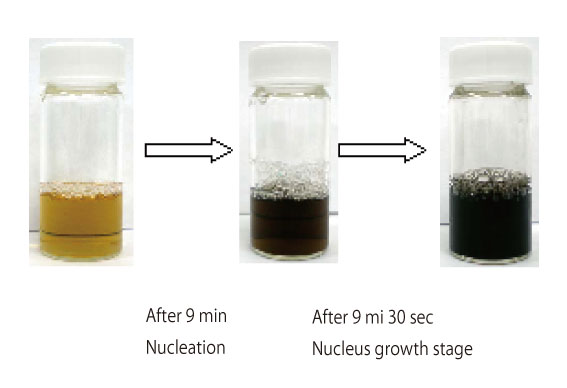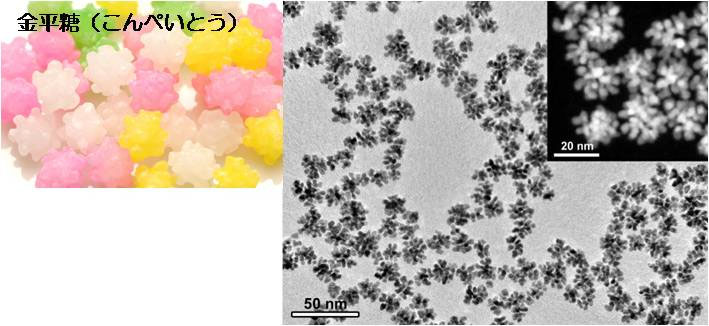Smallest Candy by Highest Technology
Platinum Nanoparticles with Ultra-Fine Structure
Jun. 23, 2009
The National Institute for Materials Science and the Japan Science and Technology Agency succeeded in fabricating ultra-fine nano-scale irregularities on the surface of platinum (Pt) nanoparticles, and succeeded in the synthesis of platinum nanoparticles shaped like kompeito sugar candy, as a novel Pt materials with a large specific area. These research results were obtained by a research group headed by Yusuke Yamauchi, who is a MANA Independent Scientist at the NIMS World Premier International (WPI) Research Center for Materials Nanoarchitectonics (MANA; Director-General: Masakazu Aono).

High resolution TEM image of platinum nano-kompeito
Platinum is known for its high catalytic activity, and is widely used in electrodes in batteries and similar products and as an industrial catalyst, for example, in the catalytic converters used to purify exhaust gas in automobiles. If it is possible to increase the surface area of platinum, the exposed area of platinum will also be increased, greatly enhancing the activity of the catalytic function. For this reason, much research has been devoted to methods of synthesizing various types of platinum nanomaterials such as nanoparticles, nanofibers, nanotubes, nano (meso) porous substances, and the like. Furthermore, in response to the recent social trend toward reduced use of rare elements, the development of new platinum nanomaterials which realize a larger area with a small amount of platinum and display higher catalytic activity is demanded.

Synthesis of kompeito platinum nanoparticle
In this research, platinum nanoparticles having a shape like kompeito sugar candy were synthesized at high speed by adding a reducing agent to an aqueous solution containing a surfactant, Pt ions, and a solvent. Utilizing the interaction between the surfactant molecules and Pt, it was possible to create nano-level irregularities (convex/concave shapes) on the surface of the Pt nanoparticles. By controlling the amount of reducing agent, it was also possible to realize a uniform particle diameter and obtain a solution in which the nanoparticles were completely dispersed. The surface area of the particles was 55m2/g or more, thus achieving the largest specific area among all platinum (Pt) nanomaterials reported to date. The thermal stability of this material was also high.
These results were obtained as part of the research topic “Nanoscale Design of Nanomaterials toward Next Generation of Magnetic Record Media” (Research Representative: Yusuke Yamauchi) in the research area “Nanosystem and Function Emergence” (Research Supervisor: Yoshihito Osada, Deputy Director, RIKEN Advanced Science Institute), in the JST’s Precursory Research for Embryonic Science and Technology (PRESTO) individual-type research program.
The research results were pulished in the following journal: Block Copolymer Mediated Synthesis of Dendritic Platinum Nanoparticles, Liang Wang and Yusuke Yamauchi, Journal of the American Chemical Society (JACS), 2009; 131(26): 9152-9153.
National Institute for Materials Science (NIMS)
Japan Science and Technology Agency (JST)
For more information

- Yusuke YAMAUCHI
- MANA Independent Scientist
- International Center for
- Materials Nanoarchitectonics (MANA)
- NIMS
- Tel. +81-29-860-4635
- Fax. +81-29-860-4721
- E-Mail :

- International Center for Materials Nanoarchitectonics (MANA), NIMS
- Tel. +81-29-860-4709
- Fax. +81-29-860-4706
Press Release Platinum Nano Kompeito: Success in Development of Platinum Nanoparticles with Ultra-Fine Structure on NIMS Website









